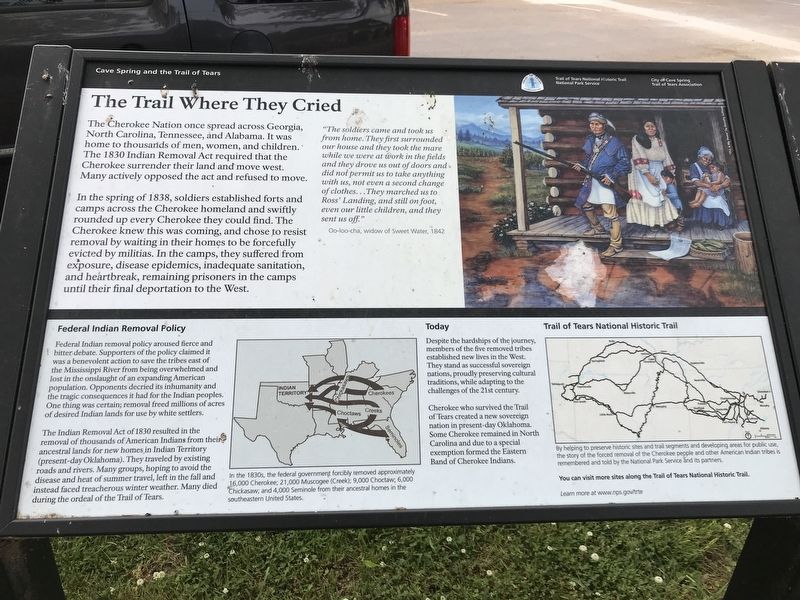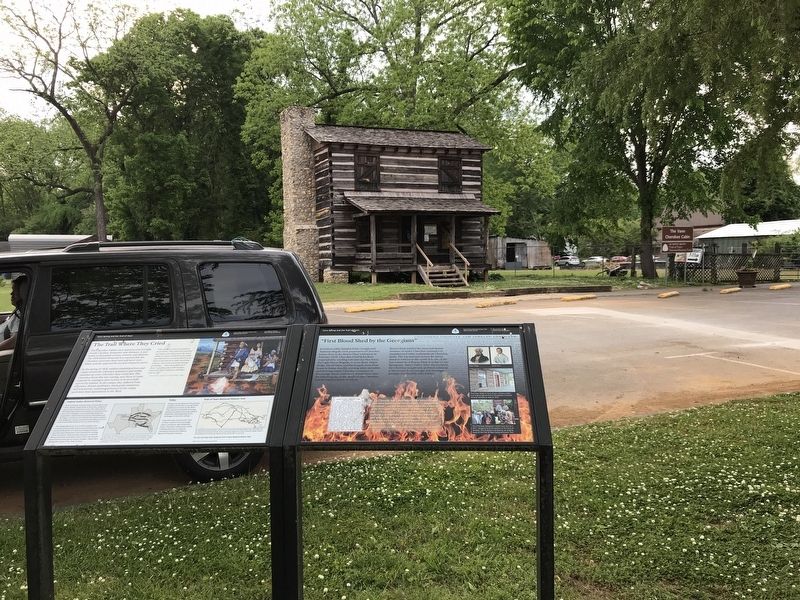Cave Spring in Floyd County, Georgia — The American South (South Atlantic)
The Trail Where They Cried
— Trail of Tears National Historic Trail —
In the spring of 1838, soldiers established forts and camps across the Cherokee homeland and swiftly rounded up every Cherokee they could find. The Cherokee knew this was coming, and chose to resist removal by waiting in their homes to be forcefully evicted by militias. In the camps, they suffered from exposure, disease epidemics, inadequate sanitation, and heartbreak, remaining prisoners in the camps until their final deportation to the West.
“The soldiers came and took us from home. They first surrounded our house and they took the mare while we were at work in the fields and they drove us out of doors and did not permit us to take anything with us, not even a second change of clothes … They marched us to Ross' Landing, and still on foot, even our little children, and they sent us off.” — Oo-loo-cha, widow of Sweet Water, 1842
Federal Indian Removal Policy
Federal Indian removal policy aroused fierce and bitter debate. Supporters of the policy claimed it was a benevolent action to save the tribes east of the Mississippi River from being overwhelmed and lost in the onslaught of an expanding American population. Opponents decried its inhumanity and the tragic consequences it had for the Indian peoples. One thing was certain; removal freed millions of acres of desired Indian lands for use by white settlers.
The Indian Removal Act of 1830 resulted in the removal of thousands of American Indians from their ancestral lands for new homes in Indian Territory (present-day Oklahoma). They traveled by existing roads and rivers. Many groups, hoping to avoid the disease and heat of summer travel, left in the fall and instead faced treacherous winter weather. Many died during the ordeal of the Trail of Tears.
Today
Despite the hardships of the journey, members of the five removed tribes established new lives in the West. They stand as successful sovereign nations, proudly preserving cultural traditions, while adapting to the challenges of the 21st century.
Cherokee who survived the Trail of Tears created a new sovereign nation in present-day Oklahoma. Some Cherokee remained in North Carolina and due to a special exemption formed the Eastern Band of Cherokee Indians.
[Captions]
• Top “This is My Home” by Dorothy Sullivan
• (Bottom, left) In the 1830s, the federal government forcibly removed approximately
16,000 Cherokee; 21,000 Muscogee (Creek); 9,000 Choctaw; 6,000 Chickasaw; and 4,000 Seminole from their ancestral homes in the southeastern United States.
• Trail of Tears National Historic Trail By helping to preserve historic sites and trail segments and developing areas for public use, the story of the forced removal of the Cherokee people and other American Indian tribes is remembered and told by the National Park Service and its partners.
Erected by National Park Service • City of Cave Spring • Trail of Tears Association.
Topics and series. This historical marker is listed in these topic lists: Government & Politics • Native Americans. In addition, it is included in the Trail of Tears series list. A significant historical year for this entry is 1838.
Location. 34° 6.413′ N, 85° 20.189′ W. Marker is in Cave Spring, Georgia, in Floyd County. Marker is at the intersection of Broad Street and Love Street, on the left when traveling south on Broad Street. Touch for map. Marker is at or near this postal address: 24 Broad St, Cave Spring GA 30124, United States of America. Touch for directions.
Other nearby markers. At least 8 other markers are within 8 miles of this marker, measured as the crow flies. “First Blood Shed by the Georgians” (here, next to this marker); 1920 Chesapeake & Ohio RR Caboose (within shouting distance of this marker); Georgia School for the Deaf (about 800 feet away, measured in a direct line); The Cedartown Water Works, Woman's Building, Big Spring Park Historic District (approx. 7.8 miles away); Trail of Tears Cherokee (approx. 7.8 miles away); Big Spring Park (approx. 7.8 miles away); Ivy Ledbetter Lee (approx. 7.9 miles away); Hawkes Children's Library (approx. 7.9 miles away). Touch for a list and map of all markers in Cave Spring.
Credits. This page was last revised on May 9, 2022. It was originally submitted on May 9, 2022, by Duane and Tracy Marsteller of Murfreesboro, Tennessee. This page has been viewed 343 times since then and 79 times this year. Photos: 1, 2. submitted on May 9, 2022, by Duane and Tracy Marsteller of Murfreesboro, Tennessee.

